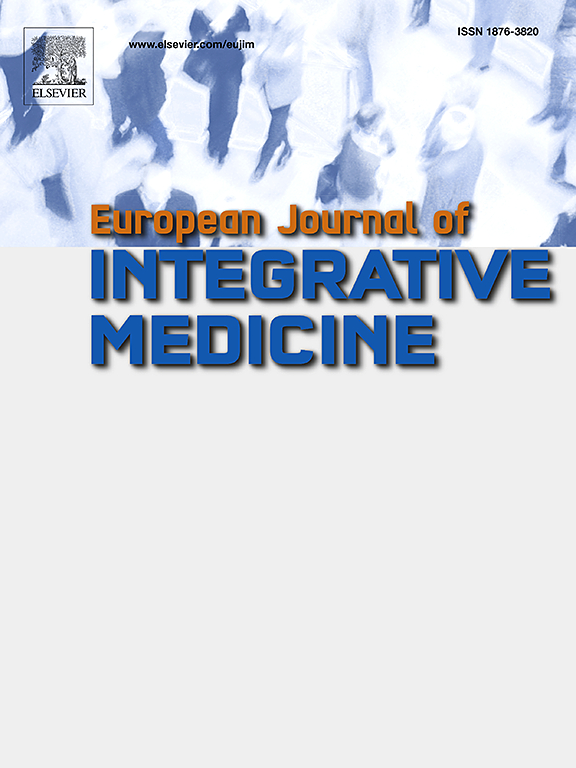脊椎推拿对治疗颈源性头痛、紧张性头痛或偏头痛有效吗?系统回顾
IF 1.7
4区 医学
Q3 INTEGRATIVE & COMPLEMENTARY MEDICINE
引用次数: 0
摘要
头痛患者经常寻求补充和替代疗法,包括脊椎指压治疗。脊椎推拿是这些患者最常用的技术之一;然而,其有效性尚不清楚。本系统综述旨在评估捏脊疗法在减少头痛患者头痛天数、发作持续时间、发作强度和药物摄入方面的有效性。方法检索自建库至2024年4月的medline (Pubmed)、PEDro、SCOPUS、Cochrane Library和Web of Science数据库。PICO搜索策略用于识别随机对照试验,应用脊椎推拿与假推拿、无额外干预或其他保守的非药物干预治疗头痛患者。符合条件的研究和数据提取由两名审稿人独立进行。采用物理治疗证据数据库量表评估研究质量,采用Cochrane协作工具评估偏倚风险。使用GRADE方法评估证据的确定性。结果8项研究从低到高的方法学质量被纳入综合,但没有进行荟萃分析。结果被分为三个亚组:捏脊手法与假手法、捏脊手法与对照、捏脊手法与深摩擦按摩。在五项比较脊椎指压疗法和假疗法的研究中,有两项发现头痛天数显著减少。在三个比较脊椎指压疗法和对照组的研究中,一个报告了头痛发作持续时间的减少。在亚组中没有观察到任何其他变量的显著差异。证据的确定性降至非常低。结论对于头痛患者,捏脊是否比假手法、对照或深摩擦按摩干预更有效尚不确定。普洛斯彼罗注册号crd42024518480本文章由计算机程序翻译,如有差异,请以英文原文为准。
Is chiropractic spinal manipulation effective for the treatment of cervicogenic, tension-type, or migraine headaches? A systematic review
Introduction
Patients with headaches often seek complementary and alternative therapies, including chiropractic care. Chiropractic spinal manipulation is one of the most commonly used techniques for these patients; however, its effectiveness remains unclear. This systematic review aimed to evaluate the effectiveness of chiropractic spinal manipulation in reducing headache days, episode duration, episode intensity, and medication intake in patients with headaches.
Methods
MEDLINE (Pubmed), PEDro, SCOPUS, Cochrane Library and Web of Science databases were searched from inception to April 2024. PICO search strategy was used to identify randomized controlled trials applying chiropractic spinal manipulations versus sham manipulation, no additional intervention, or other conservative non-pharmacological interventions in patients with headaches. Eligible studies and data extraction were conducted independently by two reviewers. Quality of the studies was assessed with Physiotherapy Evidence Database scale, and risk of bias with Cochrane Collaboration tool. Certainty of the evidence was evaluated using GRADE approach.
Results
Eight studies ranging from low to high methodological quality were included in the synthesis without a meta-analysis. The results were categorized into three subgroups: chiropractic manipulation versus sham, chiropractic manipulation versus control, and chiropractic manipulation versus deep friction massage. Among the five studies comparing chiropractic manipulation to sham, two found a significant reduction in the number of headache days. Of the three studies comparing chiropractic manipulation to a control, one reported a decrease in headache episode duration. No significant differences were observed for any other variable across the subgroups. The certainty of evidence was downgraded to very low.
Conclusions
It is uncertain if chiropractic spinal manipulation is more effective than sham, control, or deep friction massage interventions for patients with headaches.
PROSPERO registration number
CRD42024518480
求助全文
通过发布文献求助,成功后即可免费获取论文全文。
去求助
来源期刊

European Journal of Integrative Medicine
INTEGRATIVE & COMPLEMENTARY MEDICINE-
CiteScore
4.70
自引率
4.00%
发文量
102
审稿时长
33 days
期刊介绍:
The European Journal of Integrative Medicine (EuJIM) considers manuscripts from a wide range of complementary and integrative health care disciplines, with a particular focus on whole systems approaches, public health, self management and traditional medical systems. The journal strives to connect conventional medicine and evidence based complementary medicine. We encourage submissions reporting research with relevance for integrative clinical practice and interprofessional education.
EuJIM aims to be of interest to both conventional and integrative audiences, including healthcare practitioners, researchers, health care organisations, educationalists, and all those who seek objective and critical information on integrative medicine. To achieve this aim EuJIM provides an innovative international and interdisciplinary platform linking researchers and clinicians.
The journal focuses primarily on original research articles including systematic reviews, randomized controlled trials, other clinical studies, qualitative, observational and epidemiological studies. In addition we welcome short reviews, opinion articles and contributions relating to health services and policy, health economics and psychology.
 求助内容:
求助内容: 应助结果提醒方式:
应助结果提醒方式:


